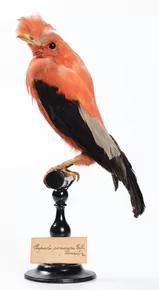
An interdisciplinary conference organised by
- Marta Lourenço and Catarina Simões (Museum of Natural History and Science, University of Lisbon),
- Alexandre Tojal (Museum of the Presidency of the Republic, Lisbon)
- Flaminia Bardati (Università di Roma La Sapienza), Julien Bondaz (Université Lyon 2),
- Emmanuel Lurin (Sorbonne Université, Paris)
- Mélanie Roustan (Muséum national d’histoire naturelle, Paris) - PuNaCa Research Program)
Led by an international and multidisciplinary scientific team, and in line with the PuNaCA research program (« Putting nature in a cage: an interdisciplinary research program on aviaries »), this event focuses on the place of non-European birds in the history of Portugal, Portuguese-speaking culture, European countries and their relations with the world, now and then. First of all, it is about highlighting the importance and the richness of the collections of birds – living, preserved, described or depicted – that were assembled, displayed and studied in the early modern period, and also some existing testimonies of these practices, kept today in Portuguese institutions (archives, museums, zoological parks, residences and historic gardens, etc.). The event will also bring together researchers and curators to initiate a reflection on these avian collections, the devices involved in their captivity and display (cages, aviaries, display cases), and also on their scientific interpretation and presentation to different audiences. The category of "exotic" birds – those which were imported, acclimatised, commodified and exploited by humans from the Middle Ages, within the framework of colonial expansions – will be questioned through the prism of history of science and knowledge, anthropology, cultural studies, architecture, landscape and art histories.
Drawing from important contributions of both the “material turn” and the “animal turn” of recent decades, we will be looking at birds themselves and also their material remains, analysing their different agencies and the diverse ways in which they were entangled and interacted with humans. Therefore, living and preserved birds and their byproducts, capture and transportation techniques, captivity constructions, architectural structures, scientific documentation practices, methods of artistic representation, structures for conservation, exploitation, representation or display will be studied from a cross-cultural perspective and in different contexts. We will be particularly interested in the relations that these avian collections, their material structures and their multiple elements maintain with the coeval imperial and colonial activities (political, scientific, commercial and so forth), the construction of ornithological knowledge in Portugal and other European countries, the history of landscapes, architecture, artifacts and taste in the Portuguese-speaking world, as well as the elaboration and dissemination of gender and racial stereotypes, from pre-imperial times to the present day.
Programme
Museum of Natural History and Science (Auditório Manuel Valadares)
Thursday 10, November
- 9h30 Opening Marta Lourenço
- 9h45 Introduction Julien Bondaz, Emmanuel Lurin, Mélanie Roustan and Catarina Simões
Session 1: Natural species and/as cultural categories
- 10h15 Patricia VIEIRA (Center for Social Studies of the University of Coimbra ; Georgetown University)
Birds and Feathers in the Land of the Parrots
-
10h45 Coffee break
-
11h15 Catarina SIMÕES (Museum of Natural History and Science, Lisbon)
Emblems, companions, agents of knowledge. Exotic birds in 16th century Portugal and their multiple cultural roles -
11h45 Discussion
-
12h Lunch
Session 2: State, power and aviaries
- 14h Emmanuel LURIN (Sorbonne Université, Centre André-Chastel)
Exotic birds for the Sun King: the Ménagerie of Versailles and its aviary (ca. 1665-1790)
-
14h30 Rafael MOREIRA (Lisbon New University, Art History Department)
Queen Mary I's Belém Palace aviary (1780-1784): iconographic program and meaning - 15h Coffee break
- 15h30 Alexandre TOJAL (Museum of the Presidency of the Republic ; History of Art Institute – FCSH/UNL)
Peacocks in Belém: an ‘explanation of birds’
-
16h Discussion
-
16h30 Departure to Belém
-
18h Visit to the royal aviary of Belém Palace (for speakers only)
Under the guidance of MM. Alexandre Tojal and Pedro Vaz
Friday 11, November
Session 3: Experiencing living collections
- 9h30 Ricardo Jorge LOPES (University of Porto, Natural History and Science Museum and CIBIO laboratory)
The Canary, from Macaronesia to the World, the successful story of a cultural icon
-
10h José Alberto PAIS (Federal University of the state of Rio de Janeiro, UNIRIO/MAST)
The birds that sang in Portuguese royal aviaries during the 18th century -
10h30 Discussion
-
10h45 Coffee break
-
11h15 Nadia VARGAFTIG (University of Reims Champagne-Ardenne)
Birds, politics and colonialism in 20th century Portugal -
11h45 Respondent
Nélia DIAS (ISCTE – Instituto Universitário de Lisboa, Department of anthropology) -
12h15 Discussion
-
12h30 Lunch
-
14h30 Hands-on workshop
-
17h Conclusion
